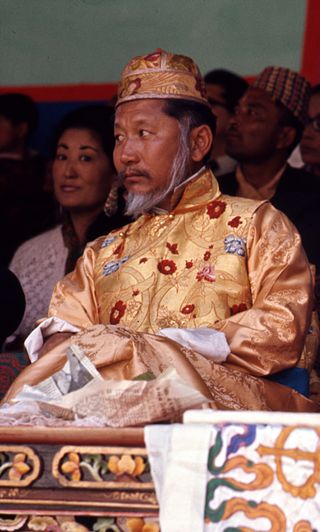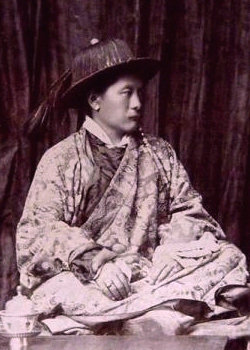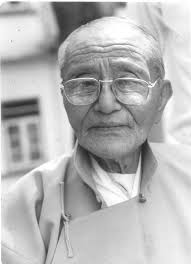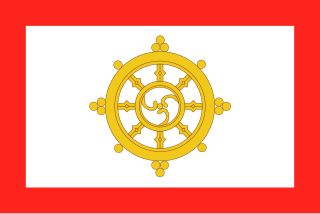Related Research Articles

Palden Thondup Namgyal was the 12th and last Chogyal (king) of the Kingdom of Sikkim.

Tashi Namgyal was the ruling Chogyal (King) of Sikkim from 1914 to 1963. He was the son of Thutob Namgyal. He was the first independent king of Sikkim.

The Chogyal were the monarchs of the former Kingdom of Sikkim, which belonged to the Namgyal dynasty. The Chogyal was the absolute monarch of Sikkim from 1642 to 1973, and the constitutional monarch from 1973 to 1975, when the monarchy was abolished and the Sikkimese people voted in a referendum to make Sikkim the 22nd state of India.

The history of Sikkim begins with the indigenous Lepcha's contact with early Tibetan settlers. Historically, Sikkim was a sovereign Monarchical State in the eastern Himalayas. Later a protectorate of India followed by a merger with India and official recognition as a state of India. Lepchas were the main inhabitants as well as the Ruler of the land up to 1641. Lepchas are generally considered to be the first people, indigenous to Sikkim also includes Darjeeling.
Tumlong is a village in the Indian state of Sikkim in northeastern India. It is located in the Mangan sub division of North Sikkim district. it is on the bank of the Dik Chu river, a tributary of the Teesta River.

Rabdentse was the second capital of the former Kingdom of Sikkim from 1670 to 1814. The capital city was destroyed by the invading Gurkha army and only the ruins of the palace and the chortens are seen here now. However, the ruins of this city are seen close to Pelling and in West Sikkim district in the Northeastern Indian state of present-day Sikkim; Pemayangtse Monastery is one of the oldest monasteries in Sikkim which is close to the ruins. From the vantage point of this former capital, superb views of the Khanchendzonga ranges can be witnessed. This monument has been declared as of national importance by the Archaeological Survey of India. It was first established in 1670 by the 2nd Chogyal Tensung Namgyal son of the 1st Chogyal Phuntsog Namgyal by shifting from the first capital of Yuksom that was consecrated in 1642.

Sir Ashley Eden was an official and diplomat in British India.

Tashi Namgyal Academy (TNA) is a public school in the Himalayan state of Sikkim in India. It was founded in 1926 by the late Sir Tashi Namgyal, KCSI, KCIE, the 11th consecrated Ruler of Sikkim. It is an autonomous English-medium, co-educational and residential-cum-day school.

Chogyal Wangchuk Tenzing Namgyal is the second son of Palden Thondup Namgyal, the last sovereign king of Sikkim. Educated at Harrow, he is also the present heir of the Namgyal dynasty and pretender to the throne of Sikkim.

Thutob Namgyal was the ruling chogyal (monarch) of Sikkim between 1874 and 1914. Thutob ascended to the throne succeeding his half-brother Sidkeong Namgyal who died issueless. Differences between the Nepalese settlers and the indigenous population during his reign led to the direct intervention of the British, who were the de facto rulers of the Himalayan nation. The British ruled in favour of the Nepalese much to the discontent of the chogyal, who then retreated to the Chumbi Valley and allied himself with the Tibetans.
Tsugphud Namgyal (1785–1863) was king of Sikkim from 1793 to 1863. He gained independence from Nepal in 1815 and ruled under a British protectorate from 1861.

Kazi Lhendup Dorjee, also spelled Lhendup Dorji or Lhendup Dorji Khangsarpa was an Indian politician who was the 1st chief minister of Sikkim from 1975 to 1979 after its union with India. He was the 1st Prime Minister of Sikkim from 1974 to 1975. He also served as the Executive Council of Sikkim from 1967 to 1970. He was a member of INC after 1975 and Sikkim National Congress before 1975.

Sidkeong Tulku Namgyal was the ruling Maharaja and Chogyal of Sikkim for a brief period in 1914, from 10 February to 5 December.

The Kingdom of Sikkim, officially Dremoshong until the 1800s, was a hereditary monarchy in the Eastern Himalayas which existed from 1642 to 16 May 1975, then it was merged with the Republic of India. It was ruled by Chogyals of the Namgyal dynasty.
Sidkeong is a given name. Notable people with the name include:

Phodong Monastery is a Buddhist monastery in Sikkim, India. It is located 28 kilometres from Gangtok. It was built in the early 18th century but an older monastery had pre-existed the current one.

Lama Kazi Dawa Samdup is now best known as one of the first translators of important works of Tibetan Buddhism into the English language and a pioneer central to the transmission of Buddhism in the West. From 1910 he also played a significant role in relations between British India and Tibet.
The Treaty of Tumlong was a March 1861 treaty between the British Empire and the Kingdom of Sikkim in present-day north-east India. Signed by Sir Ashley Eden on behalf of the British and by the Sikkimese Chogyal, Sidkeong Namgyal when his father Tsugphud Namgyal refused to return from Tibet, the treaty secured protection for travellers to Sikkim and guaranteed free trade, thereby making the state a de facto British protectorate.
Gadul Singh Lama, popularly known as Sanu Lama, is an Indian fiction writer, poet and translator of Nepali literature. An engineer by profession, he has published three short story anthologies and his stories have been translated into English, Hindi, Urdu, Assamese and Oriya languages. He is a recipient of Sahitya Akademi Award (1993), apart from other awards such as Sikkim Bhanu Puraskar, Dr. Shova Kanti Thegim Smrithi Puraskar and Madan Byakhanmala Puraskar. The Government of India awarded him the fourth highest civilian honour of the Padma Shri, in 2005, for his contributions to literature.

Princess Limbin Hteiktin Ma Lat, also Tin Tin Ma Lat, was a princess of Burma and one of the senior members of the Royal House of Konbaung.
References
- ↑ Rao, P. Raghunadha (1978). Sikkim, the Story of Its Integration with India. Cosmo
- ↑ Sikkim: Past and Present edited by H. G. Joshi
- ↑ [https://himalaya.socanth.cam.ac.uk/collections/journals/bot/pdf/bot_2009_02_02.pdf 1861 history